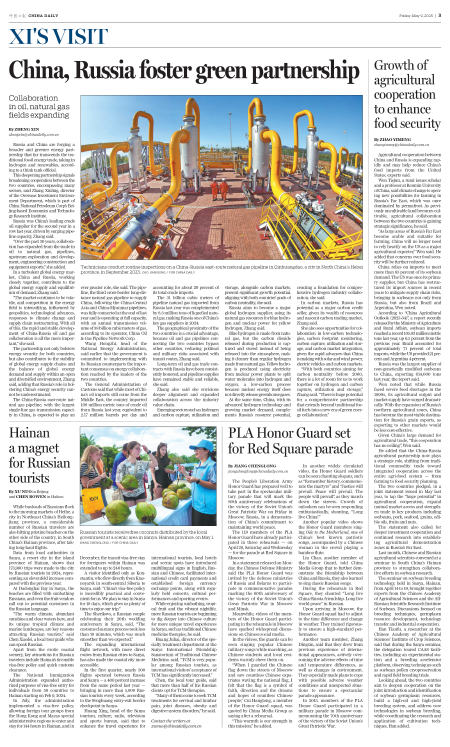Agricultural cooperation between China and Russia is expanding rapidly and may help reduce China's food imports from the United States, experts said.
Wen Tiejun, a rural issues scholar and a professor at Renmin University of China, said climate change is opening new possibilities for farming in Russia's Far East, which was once dominated by permafrost. As previously uncultivable land becomes cultivable, agricultural collaboration between the two countries is gaining strategic significance, he said.
"As large areas of Russia's Far East become arable and suitable for farming, China will no longer need to rely heavily on the US as a major agricultural exporter," Wen said. He added that concerns over food security will be further reduced.
China relies on imports to meet more than 85 percent of its soybean demand. The US was once its primary supplier, but China has restructured its import sources in recent years to mitigate supply chain risks, bringing in soybeans not only from Russia, but also from Brazil and Argentina, Wen noted.
According to "China Agricultural Outlook (2025-34)", a report recently released by the Ministry of Agriculture and Rural Affairs, soybean imports reached a record 105.03 million metric tons last year, up 6.5 percent from the previous year. Brazil accounted for approximately 71 percent of total imports, while the US provided 21 percent and Argentina 4 percent.
Russia was the largest supplier of non-genetically modified soybeans to China, exporting 614,000 tons last year, the report said.
Wen noted that while Russia faced severe food shortages in the 1990s, its agricultural output and market supply have surged dramatically. With the expansion of Russia's northern agricultural zones, China has become the most viable destination for Russia's grain exports, as exporting to other markets would be less cost-effective.
Given China's large demand for agricultural trade, "this cooperation has no ceiling", Wen said.
He added that the China-Russia agricultural partnership now plays a strategic role, shifting from traditional commodity trade toward integrated cooperation across the entire agri-food system — from farming to food security planning.
The two countries pledged, in a joint statement issued in May last year, to tap the "huge potential" in agricultural cooperation, expand mutual market access and strengthen trade in key products including soybeans, pork, seafood, grains, edible oils, fruits and nuts.
The statement also called for deeper investment cooperation and continued research into establishing agricultural demonstration zones in Russia's Far East.
Last month, Chinese and Russian agricultural scientists convened at a seminar in South China's Hainan province to strengthen collaborative efforts in soybean research.
The seminar on soybean breeding technology, held in Sanya, Hainan, from April 14 to 19, brought together experts from the Chinese Academy of Agricultural Sciences and the All-Russian Scientific Research Institute of Soybean. Discussions focused on breeding techniques, germplasm resource development, technology transfer and industrial cooperation.
Han Tianfu, a researcher at the Chinese Academy of Agricultural Sciences' Institute of Crop Sciences, said that during the Sanya seminar, the delegation toured CAAS facilities, including an experimental station and a breeding accelerator platform, observing techniques such as soybean pollen cryopreservation and rapid field breeding trials.
Looking ahead, the two countries aim to deepen cooperation on the joint introduction and identification of soybean germplasm resources, build a high-oil and high-yield breeding system, and address core technologies in soybean breeding, while coordinating the research and application of cultivation techniques, Han added.
zhaoyimeng@chinadaily.com.cn

